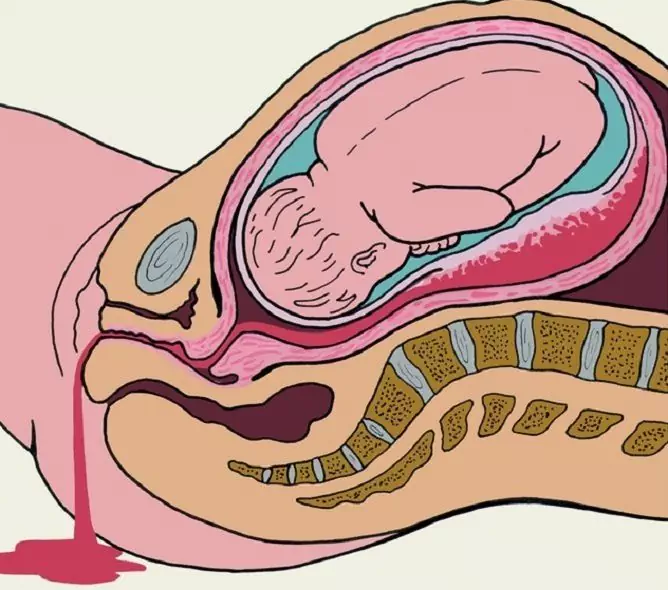- Author Rachel Wainwright [email protected].
- Public 2023-12-15 07:39.
- Last modified 2025-11-02 20:14.
False croup
The content of the article:
- False croup causes and risk factors
- Forms of the disease
- Disease stages
- False croup symptoms
- Diagnostics
- False croup treatment
- Potential consequences and complications
- Forecast
- Prevention
False croup is an obstruction of the upper airways caused by inflammation of the larynx with the development of edema of the subglottic region.
False croup is mainly observed in children in the first three years of life. This is due to the age-related features of the structure of the larynx (small size, funnel-shaped, loose subcutaneous tissue), contributing to the rapid growth of edema against the background of the inflammatory process. False croup in adults is rare and mainly has a bacterial etiology.
The incidence has a pronounced seasonality, the peak occurs in the autumn-winter season.

Synonyms: stenosing laryngitis, subglottic laryngitis, subglottic laryngitis, acute obstructive laryngitis.
False croup causes and risk factors
Most often, viral infections (influenza, parainfluenza, adenovirus, chickenpox or herpes simplex virus) lead to the development of false croup. Much less often, bacterial infections (pneumococcal, staphylococcal, streptococcal) become the cause of false croup. False croup of bacterial etiology is characterized by a severe course. If stenosing laryngitis develops against the background of laryngeal diphtheria, a diagnosis of true croup is made.
Usually false croup develops as a complication of ARVI, scarlet fever, chickenpox, measles, influenza, adenoiditis, acute pharyngitis, exacerbation of chronic tonsillitis. Factors that increase the risk of developing stenosing laryngitis are:
- the consequences of a birth injury;
- hypoxia of the fetus or newborn;
- exudative (allergic) or lymphatic-hypoplastic diathesis;
- rickets;
- hypovitaminosis conditions;
- mixed or artificial feeding;
- immunodeficiency states of various origins.
Several main pathogenetic mechanisms can be distinguished in the development of false croup:
- Inflammatory process - leads to edema of the mucous membrane under the vocal cords, which, in turn, causes a decrease in the lumen of the larynx in this area and creates an obstacle to the flow of air during breathing.
- Reflex spasm of the muscles that compress the pharynx (constrictor muscles) - leads to an aggravation of the severity of the stenosis.
- Strengthening the secretory activity of the glands of the epithelium of the larynx - leads to the formation of thick and viscous sputum in large quantities.
At the initial stages of development of the false croup, the respiratory rate increases and the work of the respiratory muscles increases. Further progression of laryngeal stenosis is accompanied by an increase in respiratory failure, hypoxic damage to all organs and tissues, but, above all, to the cardiovascular and respiratory systems. In the terminal stage of the disease, breathing becomes barely noticeable, shallow, and the pulse is threadlike. Diffuse cyanosis develops, blood pressure drops sharply. If during this period intensive therapy is not carried out, the patient falls into a hypoxic coma, against the background of which a fatal outcome occurs.
Forms of the disease
Depending on the etiological factor, false croup is divided into viral and bacterial, and in the absence or presence of complications, into uncomplicated or complicated.
Disease stages
As the stenosis of the larynx progresses during the false croup, the following stages are distinguished:
- Compensated stenosis. Inspiratory dyspnea arising during physical or emotional stress is noted, i.e., breathing is difficult.
- Subcompensated stenosis. Inspiratory dyspnea is observed not only during exertion, but also at rest.
- Decompensated stenosis. It is characterized by pronounced dyspnea of an inspiratory or mixed nature. In some cases, paradoxical breathing may develop, in which there is an increase in the volume of the chest at the time of exhalation and its decrease during inhalation.
- Terminal stenosis. It is accompanied by the development of severe acute respiratory and cardiovascular failure, severe hypoxia. This stage of the disease is often fatal.
False croup symptoms
Symptoms of false croup usually occur on the second or third day after the onset of acute upper respiratory tract disease of viral or bacterial etiology. The attack most often develops at night with the appearance of inspiratory dyspnea and noisy breathing. Dry barking cough is characteristic. There may be some hoarseness of the voice, but complete aphonia with false croup never develops. In a child, during a cry and strong crying, the hoarseness of the voice disappears, and its sonority is fully restored.

With pronounced stenosis of the larynx at the time of inhalation, the intercostal spaces and the jugular fossa are drawn in. The increase in respiratory failure is accompanied by the development of cyanosis, tachycardia, agitation. A change in the nature of dyspnea from inspiratory to mixed is an unfavorable prognostic sign.
The terminal stage of false croup is characterized by the following features:
- the disappearance of the barking cough;
- shallow arrhythmic breathing;
- bradycardia;
- arterial hypotension;
- convulsions;
- the development of a hypoxic coma.
The severity of the condition of children with false croup can vary significantly during the day.
Diagnostics
Diagnosis of false croup in most cases does not cause difficulties and is based on the characteristic symptoms of the disease, history data (acute upper respiratory tract infection) and physical examination.
With false croup of presumably bacterial etiology, a bacteriological examination of a smear from the throat is shown in order to identify the causative agent of the disease, as well as to determine its sensitivity to antibacterial drugs.
If false croup is suspected due to mycoplasma or chlamydial flora, serological diagnostics (ELISA, PCR) is necessary.
To assess the severity of hypoxia, a study of the gas composition of the blood and determination of its acid-base state are carried out.
To identify possible complications of false croup, according to indications, an x-ray of the lungs and nasal sinuses, otoscopy, rhinoscopy, pharyngoscopy are prescribed.
False croup should, first of all, be differentiated from true croup associated with diphtheria. A true croup is characterized by a slow progression of stenosis of the larynx and an increasing hoarseness of the voice up to the complete loss of its sonority (aphonia). On examination of the larynx, characteristic diphtheria plaques are found.

Also, false croup must be differentiated from a number of other diseases, namely:
- congenital stridor;
- bronchial asthma;
- lesions of the larynx with congenital syphilis;
- laryngeal tumors;
- retropharyngeal abscess;
- acute epiglottitis;
- foreign body of the larynx;
- allergic laryngeal edema.
False croup treatment
Treatment of false croup is aimed at stopping the attack and preventing its recurrence, relieving swelling and inflammation of the laryngeal mucosa. The child needs to create a calm environment, provide fresh air and warm alkaline drinks. Considering that the condition of children with false croup can change significantly during the day, their hospitalization in a specialized department is indicated.
Medical treatment of false croup includes taking antitussives and antihistamines, corticosteroids, sedatives. Children are shown alkaline inhalation. When the patient is in serious condition, he is placed in an oxygen tent or tracheal intubation is performed and transferred to auxiliary or artificial ventilation.

Antibiotics are prescribed for bacterial false croup or complications.
The following methods can be used to relieve reflex spasm of the muscles of the laryngeal constrictors and thereby weaken the severity of an attack of false croup:
- cans on the back;
- warm compresses on the chest;
- hot foot baths;
- induction of vomiting by pressing on the root of the tongue;
- provoking sneezing (tickling the nasal mucosa with a piece of cotton wool).
Potential consequences and complications
The accession of a secondary infection leads to the development of bacterial complications of false croup: pneumonia, otitis media, sinusitis, conjunctivitis, tonsillitis, purulent meningitis.
Forecast
With timely treatment of false croup, the prognosis is usually favorable. It worsens with the addition of complications or the initiation of treatment for false croup in the stage of decompensation.
Prevention
Prevention of false croup is based on the following activities:
- prevention of contact with patients with infectious diseases;
- increasing the body's defenses (adherence to the daily regimen, proper nutrition, regular walks, adequate and regular physical activity);
- vaccination against measles, influenza and other potentially dangerous infections.
YouTube video related to the article:

Elena Minkina Doctor anesthesiologist-resuscitator About the author
Education: graduated from the Tashkent State Medical Institute, specializing in general medicine in 1991. Repeatedly passed refresher courses.
Work experience: anesthesiologist-resuscitator of the city maternity complex, resuscitator of the hemodialysis department.
The information is generalized and provided for informational purposes only. At the first sign of illness, see your doctor. Self-medication is hazardous to health!






